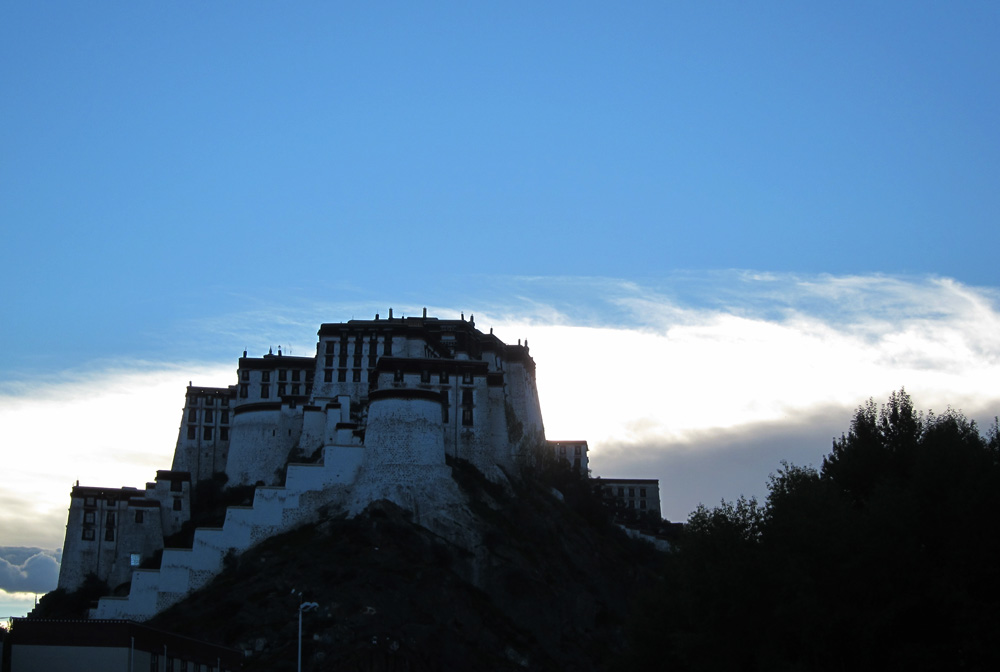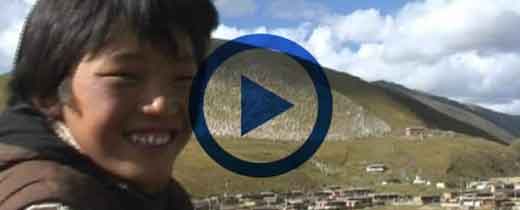
Tibet History Structure is a simple way to quickly understand Tibet history
The simplest method by two segments
If to divide Tibet history in the simplest way, which the historical process that has stretched for thousands of years on the snow-covered plateau, can be simply divided into two parts then.
Tibet History Structure — The 1st part
Before 1247 AD
An independently developed kingdom from primitive to slavery society
Tibet History Structure — The 2nd part
After 1247 AD
Regional local government which under the administrative management of the Chinese central government
The important historical event that separated these two parts was the “Liangzhou Meetings of Sovereigns in 1247 AD“, in which an agreement was reached that the entire Tibet became a part of China from an extraterritorial area for the first time. And hence, no matter which regime was in power on Tibet that the word “Local” should be added before its name
Before 1247 AD, this snow-covered plateau was remote and unfamiliar to the Central dynasties. No matter what it was called before, there was no affiliation between Tibet and the Central dynasties during this period. In order to fight for living space, the Tubo Dynasty and the Tang Dynasty broke out in a war that lasted for more than 150 years.
On the front stretched for thousands of miles from Sichuan Jiannan in the east to Patola Sahi (now Kashmir) in the west. Tibet and Tang Dynasty (618 AD – 907 AD) dispatched millions of soldiers and fought more than 190 times.During this period, the Central dynasties and Tibet were completely state-to-state relations, and even a life-and-death state relationship.
After 1247 AD, whether it was the Sakya Sect of Yuan Dynasty (1271 AD – 1368 AD) , the Phagmo Drupa of the Ming Dynasty ( 1368 AD – 1644 AD) , or the Kashag regime of the Gelug Sect of the Qing Dynasty ( 1636 AD – 1912 AD) , they were all under the jurisdiction of the Central Government of China, which was equivalent to the Stationed agencies in Tibet assigned by central government, and every time when the regime changed, it must be reported to the central government and approved by the corresponding edict to indicate the legitimacy of its governance.
The two key figures of “Liangzhou Meetings of Sovereigns in 1247 AD”
Godan Borjigin (AD 1206-AD 1251),The second son of the Mongolian Empire Ogedei Khan of Yuan Dynasty (AD 1271-AD 1368), a military strategist, and an important member of the Borjigin Family
Sakya Pandita Kunga Gyeltsen ( in short Sakya Pandita, AD 1182-AD 1251) was also spelled as Sagya Pantida Gunga Gyacan, Tibetan spiritual leader and Buddhist scholar and the fourth of the Five Sakya Pa Forefathers
The method by Four segments
A slightly more complicated way to learn Tibetan history can also be divided according to the political structure of each historical period. Then from the ancient times of Tibet to the reform of the society system in 1959, that can be simply divided into four major segments: “Mythical Age”, “Dynasty Age”, “Separatist Era”, and “Religious Sects Governing Age”.
Tibet History Structure — Phase 1 — The Age of Mythology
The historical records of this stage are circulated in the form of myths and legends like all other civilization. For example, Tibet has its own legend of the origin of Tibetan race-the intercourse and reproduction of Macaques and Rakshasa girl
Later, with the continuous development of social productive forces, tribal alliances and tribal states began to appear in various places in Tibet.
According to Tibetan historical records, many small states appeared during this period that were called “12 small states“, “24 small states“, etc. There was even a great kingdom of Zhang Zhung, which covered a huge area that included Kashmir in the west, the Tibetan areas of Qinghai and Sichuan in the east, neighbouring Khotan in the north, reached Nepal and the northern part of the South Asian subcontinent in the south,
With the increasing power of the Tubo Kingdom that originated in the Yarlung River Valley (now Shannan City, Tibet), it crossed the Yarlung Tsangbo River and destroyed the Sum-pa Kingdom, and then sent troops to Ngari to destroy Zhang Zhung Kingdom. From then on, the history of Tibet had entered the “Dynasty Age” dominated by the Tubo dynasty from the “Mythical Age”
In the long period of Mythical Age, there are three historical figures worth remembering, whom are Nyatri Tsenpo, Trigum Tsenpo, and Thothori Nyantsen Tsenpo,
“Nyatri Tsenpo“, it is said that he was from the sky (meaning the son of the gods), and was the 1st king of Tubo. It is estimated that his time as a king was about 360 BC – 329 BC. As an “outsider”, “Nyatri Tsenpo” successfully established Tubo Kingdom, and ascended to the throne with the support of the Bon religion
“Trigum Tsenpo” was the 8th generation king of Tubo. During his reign (146 BC – 123BC), he could not bear the interference of the Bon religion on the royal power and initiated a campaign to suppress the Bon religion. Unfortunately, He was eventually assassinated and died.
“Thothori Nyantsen Tsenpo” was the 28th generation king of Tubo. According to legend, during his reign (432 AD – 512 AD?), a treasure box containing Buddhist scriptures and statues fell from the sky, however, the Buddhist scriptures were written in Sanskrit that Tubo people could not read. Therefore, it was named “Nyapo Sangwa” (menaing “Mysterious objects belonging to Deity”) by “Thothori Nyantsen Tsenpo”, and it was properly collected and enshrined, hence, he was rejuvenated at the age of 60 and lived another 60 years.
From this legend, it can be understood as early as the five-generations of Tupo king before Songtsen Gampo that India Buddhism began to be spread in Tubo kingdom, but it ended in failure.
Tibet History Structure — Phase 2 — Tubo Dynasty
” Dynasty Age” was initiated by Songtsen Gampo – the Tubo Dynasty
One point must be explained that “Tubo kingdom” and “Tubo Dynasty” are two terms with completely different meanings.
A conclusion has been formed in Tibetan historians in China and abroad that Tubo regime, which had lasted for more than two hundred years after Songtsen Gampo, was qualified to be named “Dynasty”. The Tubo regime before Songtsen Gampo can only be called the “Tubo State” Or “Tubo Kingdom”.
Ever since Songtsen Gampo selected Lhasa as the capital of his kingdom, then a series of political, military, and cultural reforms were carried out by imitating the Tang dynasty that included establishing the ranks of officials, unifying the measuring instruments, and ecreating Tibetan language, all of which graduly established a military empire with strong influence on foreign political powers
As the Tubo dynasty gradually began to interact more closely with the Tang dynasty under the rule of Songtsen Gampo, then the history of the Tang dynasty began to record many aspects of Tubo dynasty. The rigorous and standardized way of historical description in the Central Plains (with strict chronological marks) has become an indispensable coordinate system and supporting evidence for the study of Tubo history. As a result, Tibetan history broke away from the “mythical age” filled with legends and formally entered the “recorded historical age“.
In 842 AD, the domestic political struggle in Tubo became irreconcilable, and the last Tsenpo Langdarma was assassinated by Buddhists. The once glorious Tubo dynasty completely collapsed, Tibet was immediately shattered into countless pieces, and was divided and occupied by various small lords.
Tibet History Structure — Phase 3 — Separatist Era
The product of the “Separatist Era” was the sects of Tibetan Buddhism.
Since the collapse of the Tubo dynasty, Tibet history entered a period of more than 400 years of separatist’ rule. During this long period of time, no regime had the ability to unify Tibet.
Due to the lack of influence on external world, the Central goverment no longer paid attention to Tibetan affairs, so that historians did not even intend to distinguish the names of various Tibetan regimes, but roughly called “Tubo tribes” of the all. Therefore, the long history of Tibet’s “separatist era” had once again become blurred.
What we are clear at present is that the descendants of the Tubo royal family established a series of small regimes in various places far away from Lhasa. Among them, the more famous ones were Gusiluo Regime with capital of Xining, the Guge Regime with capital of Zanda, the Ladakh Regime with area of Indian-controlled Kashmir-Leh), the Gongtang Regime with area of Gyirong County, and Rabri (Lagari) Regime with area of Qusum County
Compared with these regimes in remote areas, the core area of Tibet had long been controlled by various smaller Tibetan lords. The most important legacy left by this broken regime structure was the creation of numerous religious sects in a very short period of time.
After Buddhism being introduced in Tibet, there were no sects of religous for hundreds of years, but under the time “Separatist Era”, religious sects became one of the best labels that distinguished people who were from the land of the local Tibetan lords. With the support of local lords, the rising sects of Tibetan Buddhism laid a solid foundation for Tibet to enter “Religious Sects Governing Age” in the future.
And with the trip to Liangzhou by Sakya Pandita, the fourth of the Five Sakya Forefathers, the course of Tibet history had completely turned, that it is integrated into the Chinese civilization from an outer region
Tibet History Structure — Phase 4 — Religious Sects Governing Age
“Liangzhou Meetings of Sovereigns in 1247 AD” not only marked that Tibet became an inseparable part of Chinese territory, but also marked the first spiritual confluence of the two components of the Chinese nation, the Mongolian and the Tibetans. As a sign of this spiritual confluence, Mongolian people began to generally believe in the Tibetan Buddhism; The power and ruling foundation of the Sakya Sect were entirely based on the spiritual confluence between the two ethnic groups.
In the Yuan Dynasty (1271 AD – 1368 AD), the Sakya Sect gained leadership in Tibet, but with the rapid decline of the Yuan Dynasty, the Sakya Sect’s leadership in Tibet lasted only more than 70 years.
When the Ming Dynasty(1368 AD – 1644 AD ) was established, the central government changed the policy of the Yuan Dynasty’s of respecting the Sakya pa alone.
In addition to setting up troops in Tibet, vigorously conferring religious leaders of various sects, implementing the monk official system, strengthen the influence of the Ming Dynasty on the vast Tibetan areas through the profound influence of Tibetan Buddhism.
The so-called “Eight Kings of Tibet” was the ultimate manifestation of this policy. The leaders of different sects of Tibetan Buddhism were investiture of the “Three Kings of Dharma” and the “Five Local Kings” respectively. In the early days of the Ming Dynasty, the most powerful leader in the core area of Tibet was no longer the Sakya pa, but the Phagmo Drupa regime led by the Tibetan politician Changchub Gyaltsen(1302 AD ~ 1364 AD)
In 1364 AD, Changchub Gyaltsen left a legacy before his death, “The emperor cared for Phagmo Drupa before, and if he continues to care, he should abide by the emperor’s decree, welcome, send, and declare imperial envoys.”
The descendants of Changchub Gyaltsen faithfully implemented his ideas and cooperated well with the emerging Ming Dynasty government.
In March of the fourth year of Yongle reign of Ming Dynasty (AD 1406), the leader of the Phagmo Drupa regime, Dragpa Gyaltsen, was awarded the title of “King of the Empowerment of the State Master”. This was the beginning of the Ming dynasty’s entrustment of Religous leaders in Tibet, and it has been inherited from generation to generation. In the ninth year of the Xuande period of Ming Dynasty (AD 1434), the title of “Great Merciful King” was awarded by Emperor Xuanzong. From that time on, the Ming Dynasty’s “Three Kings of Dharma” and the “Local Five Kings” had all been put in place.
Since then, there had not been a single incident in Tibet that dared to challenge the authority of the central government during the more than 200 years’ rule of the Ming Dynasty.
It also can be seen that the “multi-feudal construction” policy of divide and rule of Tibet that was initiated by Ming Dynasty was quite effective.
Later, in the late Ming and early Qing dynasties, with the decline of Phagmo Drupa’s regime, two former retainers of Phagmo Drupa, “Rinpungpa” and “Xinshapa (Tsangpa)” rose one after another.
During these two relatively short periods of regime dominance, Tibet’s most powerful sect became the Karma Kagyu Sect, and what their spearhead was pointing at was the Gelug pa founded by Tsongkhapa.
In 1577 (the fifth year of Wanli Emperor of Ming Dynasty), the Gelug Sect leader Sonam Gyatso (3rd Dalai Lama), who was marginalized in Tibet, rushed to Qinghai and to meet with the leader of the Mongolian Tumote tribe, Altan Khan, at the Yanghua Monastery (in Tibetan, Techen Chokling, destroied in 1591 AD) by the Qinghai Lake
So far, the second spiritual confluence occurred between the Mongolian and Tibetan ethnic groups, laying the foundation for the subsequent rise of the Gelug Pa. And this meeting had a profound impact on the history of Tibet that not only did Sonam Gyatso gain the honorary title of “Dalai” bestowed by Altan Khan, and also with the influence of “Altan Khan”, many Mongolian tribes became believers of the Gelug pa.
Especially when Sonam Gyatso passed away, the next generation of “Dalai Lama” was reincarnated in the home of Mongolian nobles (great grandson of Altan Khan), which made the relationship between Mongolia and Gelugpa closer.
It was precisely by virtue of the military strength of the Mongolian tribes that the Gelugpa survived the low era and finally defeated the Tsangpa regime, which believed in Karma Kagyu Sect. Furthermore, by virtue of its huge influence on Mongolian forces, the rulers of Qing Dynasty who lived in the Central Plains could not underestimate it.
When the emperor of the Qing Dynasty decided to adopt the policy of “prospering the Gelug pa to secure the Mongolian”, the Gelug pa finally stood on the forefront of dominating the local affairs of Tibet after a long and arduous trek.




